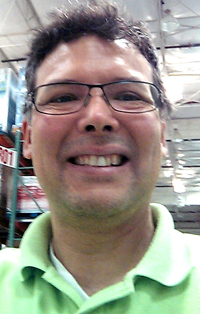By Irfan Shariff
Northwest Asian Weekly

Chris Kenji Beer
Chris Kenji Beer does not play the koto. He does, however, know the sound of the 13-stringed national instrument of Japan.
The koto is a zither, or a musical instrument with strings stretched across a flat, wooden body. It can measure almost six feet in length and is played by plucking at the strings with one of three picks attached to the player’s fingers. Beer grew up listening to the koto playing around the house.
On July 5, Beer will perform classic koto music on the piano and electronic keyboard at Brass Tracks in Seattle’s Georgetown neighborhood.
“I play a rare and innovative integration of classical Japanese koto music with a Western jazz rhythm,” said Beer. “It presents a long-time, traditional music style in a new and energetic light.”
Beer credits the Shinto reverence to the natural world as his musical inspiration and hopes that these undertones are projected through his music.
He calls his music Koto Jazz.
Beer differentiates this from jazz koto, which “uses the koto instrument in standard jazz musical performances,” he said.
By the 1970s and 1980s, the koto was introduced into popular Western music. David Bowie, The Rolling Stones, and Queen have all experimented with the koto in their music.
 Beer can’t pinpoint another artist that does what he does on a regular basis — incorporating Japanese koto sounds and chordal structure using Western instruments.
Beer can’t pinpoint another artist that does what he does on a regular basis — incorporating Japanese koto sounds and chordal structure using Western instruments.
“Masahiko Satoh comes the closest,” said Beer. “He is a jazz pianist and has used the Japanese koto sounds in one of his songs.”
Beer takes his inspiration from jazz artists, such as George Winston, Li Pui Ming, Riley Lee, Scott Cossu, and artists represented by Windham Hill Records, a record label that specializes in New Age
Jazz music, he said.
“Winston takes a number of Western classical music like ‘Ode to Joy’ and ‘Canon in D Minor’ and adds jazz and modern rhythm to them. Likewise, I attempt to do the same with classical Eastern koto music,” said Beer.
Beer grew up primarily in Seattle and Boulder, Colo., but spent several formative years in Japan. He went on to study abroad at Jouchi Daigaku (Sophia University, Tokyo) during college.
“As a child, I listened to the music of my mother’s heritage,” said Beer. He remembers growing up to koto music playing in the background.
“I didn’t come to really appreciate it until I became a young adult,” he said.
“I took formal piano lessons up to the third grade,” said Beer, “but I really blossomed when I began playing by ear listening to pop and rock. I began experimenting with traditional Japanese koto music.”
His first experiment was “Sakura” (Cherry Blossom), a traditional Japanese folk song made for the koto.
“While I loved the simple melody of this famous piece, I had a Western itch about me and I banged it out like a rock tune,” he said. “After much practice, I learned to moderate and temper.”
Beer’s favorite koto piece is “Tori No Yo Ni” (Like a Bird) by legendary koto player and composer Tadao Sawai. Sawai is known to have performed classical Bach pieces on the koto. He will perform “Sakura” and “Tori No Yo Ni,” as well as the famous “Haro no Umi” during his performance at Brass Tracks.
“Haro no Umi” (The Spring Sea) is considered to be one of the best-known compositions for the koto and shakuhachi (a flute-like instrument). It was written in 1929 by Michio Miyagi, who was known for his skilled koto playing, and is considered his most famous work. His music helped keep the koto tradition alive as Western influences made headway into Meiji-era Japan. (end)
To learn more about Koto Jazz, visit http://www.kotojazz.com.
Chris Kenji Beer performs at Brass Tracks, 6031 Airport Way S., Seattle, on Saturday, July 5, at 9 p.m. Admission is free.
Irfan Shariff can be reached at info@nwasianweekly.com.

